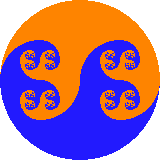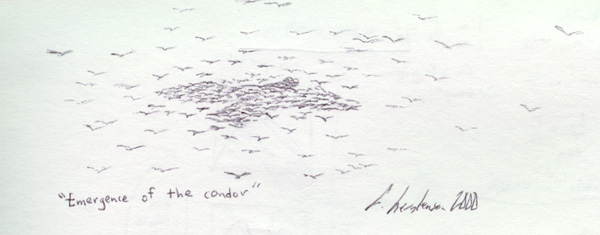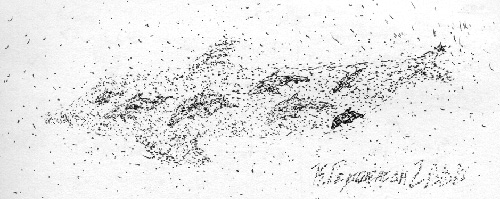
"There are souls that will never be discovered, unless we start by inventing them"
--Nietzsche

"Emergence of the Condor". Carlos Gershenson, Mexico City, 2000. Ink on paper.

"Dolphins out of unbounded chaos". Carlos Gershenson, Mexico City, 2000. Gel on paper.
In this chapter we will expose Artificial Societies (AS) and previous work that has been made using them. But first, we will give some notions of what is a complex system, since societies are complex systems, and we will use the terminology through this work.
"A complex object is an object which has more than one non-overlapping description"
--Jack Cohen
Indeed defining complex systems is a complex task. There are more than seventy definitions of complexity, used in diverse areas. We can say that there are many non-overlapping descriptions of complex systems, perhaps because it is inspired in practically all branches of knowledge, and also because it is a very new field of study (Bar-Yam, 1997).
With this panorama, we will not attempt to define complex systems. We will only try to describe them.
A complex system is usually constituted of many elements which interact. The complexity of the system is proportional to the number of elements, the number of interactions in the system, and the complexities of the elements and of their interactions. In natural complex systems, every element is also a complex system, therefore we can only obtain a relative complexity depending on a reference point. Since we can use various reference points, there cannot be an absolute complexity, and each relative complexity will be different.
The global behaviour of the system arises from the interactions of the elements of the system. In this sense, we can say that a complex system is more than the sum of its parts.
A complex system has properties not present in its parts. These properties are called emergent. They emerge from the interactions of the components of the system.
There is not a crisp boundary between complex and simple systems. Also the complexity of a system is strongly dependent from the context in which it is being studied. But generally speaking, simple systems are easily predictable, have a single or few parts, and few or none interactions. There is little or no emergence in a simple system. Examples of simple systems might be:
We can see that the behaviour of the system might be easily predicted or described with few rules or formulae. Also, they are not too abundant in nature. If we look around, most things surrounding us are complex systems. Some examples might be:
Other examples of complex systems might be the weather, traffic jams, Mother Web, the stock market, and an ecosystem.
We suggest the reader to think about natural systems, and think if they're complex or simple. Most of them are complex (otherwise the reader is simple minded???).
A usual mistake is to confuse complexity with complication. A complex system might be complicated or not, and vice versa. Other usual mistake is to confuse complexity with chaos. A complex system might also be chaotic or not, and vice versa.
The approach of complex systems allows to understand the behaviour of the system by understanding the behaviours and interactions of its parts. Studying the system as a whole is too complicated. And studying only the parts of the system does not allow to understand the behaviour of the whole system and its emergent properties.
In the last few years, several companies have solved problems in different businesses using complex systems techniques with very good results (Wakefield, 2001).
BBS might not be complex systems, but adaptive behaviour is indeed a complex system. Adaptive behaviour in animals (and even in bacteria), requires the interaction of many components to provide robust perceptions, action selections, and actuations. If adaptive behaviour would be made out only of simple rules (IF food AND hunger THEN eat), it would not be capable of adaptation in an unpredictable environment (IF Boeing 757 AND unknown noise THEN... !). So, a good BBS will be also a complex system. Some properties of a BBS, like those of an animal, will emerge from the interaction of its components.
An individual belonging to a society, natural or artificial, might be complex or not. But in a society, its individuals have to interact (otherwise they would not be social, we would have just a population). Thus, a society is a complex system (Goldspink, 2000). And social phenomena emerge from the interactions of the members of a society.
Perhaps the most simple example of this might be given by cellular automata, such as The Game of Life (1) (Conway, 1970; Gershenson, 1997). Each cell is represented by a "life" value in a matrix, which is regulated by simple rules that take into account the "life" values of the neighbouring cells. With these simple rules, complex behaviours emerge, present in natural cell colonies, such as pattern formations and oscillations in structures, translations, generations, and even predations.
With such examples it has been seen that complex social phenomena might emerge from the interaction of simple individuals. But, if the individuals are complex systems themselves, with emergent properties, the potential of emergence is increased.
"One day the creator searched for the companions and the sons of his hope,
and it came that he could not find them if he did not start by creating them himself."
--Nietzsche
Yes. An artificial society (AS) is a synthetic representation of a society. It simulates social phenomena. Artificial societies are used to understand how societies work by synthetically creating them (2).
Societies were considered to be groups only of humans. But again, since we consider that animals and artificial creatures are also capable of exhibiting intelligence, we consider a society as a group of individuals (humans, animals, animats, etc.) exhibiting intelligence and interacting socially among them.
Sociality presupposes two or more agents in a common shared world. If we do not want them to be a mere population, they need to interact. If this interaction is made as an agent with a goal-oriented behaviour (3) dealing with another entity as an agent, then we can say that the interaction is social (Castelfranchi, 1998). This is because an agent could see another agent, for example, as a moving obstacle, without goals. The behaviour would not be social. A social behaviour needs not only two or more interacting agents, but these agents need to perceive each other as their similar.
Some theories about joint or group action (Tuomela, 1993) are built on the basis of individual action. But we agree with Cristiano Castelfranchi, who also notes the importance of the individual social action (Castelfranchi, 1997). In a society not only the individual action should have a social perspective, but also the individual action is influenced by the society.
There can be social action among non cognitive agents, but most social phenomena involve the interaction of cognitive agents (agents that are able to know). We believe that a cognitive agent does not need to have an explicit mental (knowledge) representation of goals and beliefs, because these can emerge (4).
We can distinguish two types of social action (Castelfranchi, 1998): weak social action, which is based on beliefs about the mind of other agents; and strong social action, which is based on goals about others' minds and actions. A weak social action considers what another agent is doing, and might affect the considering agent. A strong social action involves social goals. A social goal is directed towards another agent. This is, the social goal of one agent is to influence the mind or actions of another agent.
Social structures and organizations emerge from social actions of the agents, and also the individual actions of the agents in a society are influenced by social structures and organizations.
Given our notion of sociality in agents, we can see that many multi agent systems (Russel and Norvig, 1994) have some kind of sociality (Hogg and Jennings, 1997; Jennings and Campos, 1997). Here we will just review some of the work in AS that are related with the study of societies. This is, AS that were created with the purpose of studying social processes. AS that are a synthetic representation of a society, and not only works involving social agents with other purposes.
Perhaps the most classical work in AS is the one of Epstein and Axtell (1996). They used a cellular automaton with "simple" rules, which caused the emergence of complex processes in the global system, such as population migration, cultural evolution, and warfare (Epstein and Axtell, 1996). This work was severely criticized by some, and admired by others. This was because some people did not believe on how such complex and obscure things could be explained with such simple rules, while others were amazed by it.
Mitchel Resnick (1994) in his book "Turtles, Termites and Traffic Jams" showed clearly how very complex social phenomena, as ant foraging, termite nest building, and traffic jams, are caused by very simple local rules. But when thousands of individuals follow simple rules, the behaviour of the systems turns out to be very complex, with social properties emerging.
The fascinating work of Gode and Sunder (1992) of "zero intelligence" traders shows that simple agents, without the capability to theorize, recall events, or maximize returns, but only bidding in ways that would not yield to immediate losses, were 75% efficient. When they replaced the agents with humans, the efficiency was 76%. This showed that the institutional settings and constrains of a system may determine the role of the individuals of the system, instead of the individuals determining it by themselves. This means that in such systems a human will not perform much better than even a random selection generator.
Artificial societies have also been useful in the social sciences. For example, Jim Doran has made a simulation where the agents might have collective misbelief (Doran, 1998). He uses this simulation for studying ideologies in human societies. Dwight Read has studied the relationship between culture and behaviour also with artificial societies (Read, 1998). There can be found many other examples, and we can see that AS, although very recent, is a rapidly growing area of study.
AS are headed towards the understanding of social processes, where theories were very hard to prove because the long duration of real social processes, but thanks to computer simulations, theories can be not only proven, but also proposed by studying artificial societies.
"It is not that you cannot understand it,
it is that you cannot compute it."
Synthetic representations of societies are useful for understanding the complex processes that take place in societies. The shaping of the society by the individuals and their environment, and the shaping of the individuals by their society, is crucial in the understanding of intelligence and cognition.
Before presenting our model for social action in Chapter 4, we will present in the next chapter the Behavioural Columns Architecture, a behaviours production system which is able to simulate animal intelligence in individuals. Intelligence desired in order to simulate complex social phenomena.
1. Programs of the Game of Life, in two dimensions (using boolean, fuzzy, and multidimensional (Gershenson, 1998a; Gershenson, 1999) logics) and in three dimensions with source code can be found at https://bingweb.binghamton.edu/%7Ecgershensong/unamjlagunez
2. See Section 1.1.
3. A goal oriented behaviour is based on the operational notion of goal and purposive behaviour (Rosenblueth and Wiener, 1968).
4. We will discuss the emergence of cognition from non-cognitive processes in the next chapter.
Carlos Gershenson